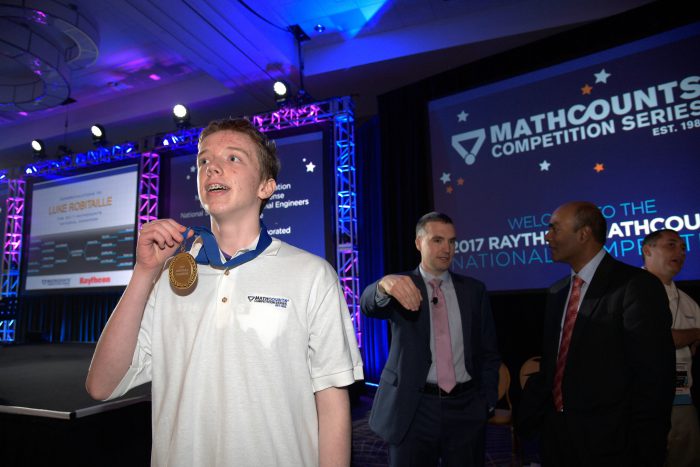In a barn, 100 chicks sit peacefully in a circle. Suddenly, each chick randomly pecks the chick immediately to its left or right. What is the expected number of unpecked chicks?
Do you know the answer? Luke Robitaille did. And because he did, he was able to win the Raytheon Mathcounts National Competition on Monday in Lake Buena Vista, Florida. Now he's receiving a $20,000 U.S. college scholarship and a trip to Space Camp in Huntsville, Alabama.
Lucky guy? Sure, but you've got to be good to be lucky, which is what this competition is all about. Giving students the inspiration and opportunity to get better in subjects like math and science.
Starting with a STEM
Former president Barack Obama welcomes students to the 2015 White House Science Fair. The annual fair brings together winners of various STEM competitions from across the country. (Getty Embed)
Organizers across the United States and Canada have created programs like Mathcounts to help get more and more young people excited about pursuing STEM degrees and careers. STEM is an acronym for Science, Technology, Engineering, and Mathematics. Experts think that these fields are going to have the most opportunities, or jobs, in the future.
The Raytheon Mathcounts National Competition is an American competition for sixth, seventh, and eighth graders. It is a little like a math equivalent of the well-known Scripps National Spelling Bee. There were 224 contestants accepted. A written test got that number down to 12 contestants, who entered the final round on Monday. After that, the first kid to four correct answers won!
Luke was tied 3 to 3 with his fellow finalist when he buzzed in to correctly answer the final question. He buzzed in in less than a second! Lightning Luke!
And the answer is...
By the way, the answer to the problem at the top of this post? It is 25 chicks. Here's how you solve it.
All the chicks have the option of pecking either to their left or their right, but not both. In other words, there is a 50% chance of pecking left and 50% chance of pecking right. Let's focus on one chick, Gary. He has one chick on either side of him (let's call the chick to his left, Cheep, and the one to his right, Chirp). Gary has a 50% percent (or 0.5) chance of not getting pecked by Cheep, and the same chance (0.5) of getting missed by Chirp. To find out the chance that both Cheep and Chirp miss Gary, we multiply those percentages together: 0.5 x 0.5 = 0.25. So there is a 25% chance that Gary (and all of the other chicks) will not get pecked by either of the two chicks beside them.
Therefore, 0.25 (or a 25% chance of being pecked) x 100 chicks = 25 chicks.
Pretty neat, huh? Now remember that Luke figured this out in less than a second. Whoa!
Contest alert
Don't miss our Science Odyssey Family Contest. Click HERE TO ENTER.
Science Odyssey is a 10-day, Canada-wide celebration of all things science, technology, engineering, and math (STEM). Find activities in your area HERE.
 Mathcounts National Competition winner Luke Robitaille shows off his gold medal on Monday. (Raytheon)
Mathcounts National Competition winner Luke Robitaille shows off his gold medal on Monday. (Raytheon)









